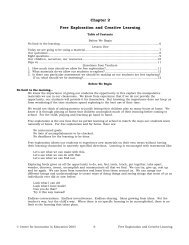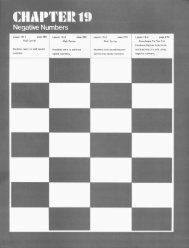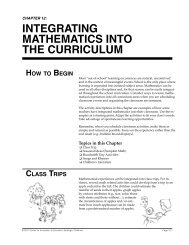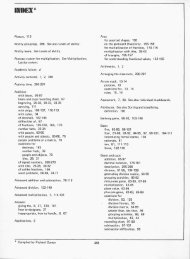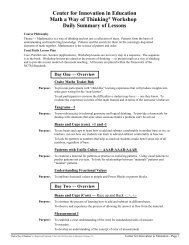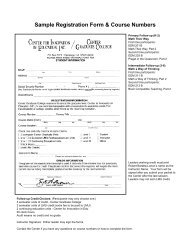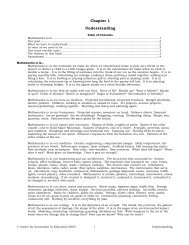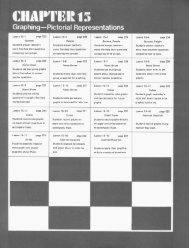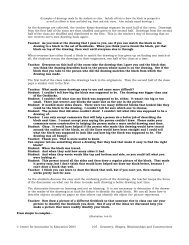Chapter 11 Fractions, Ratios, Money, Decimals and Percent
Chapter 11 Fractions, Ratios, Money, Decimals and Percent
Chapter 11 Fractions, Ratios, Money, Decimals and Percent
You also want an ePaper? Increase the reach of your titles
YUMPU automatically turns print PDFs into web optimized ePapers that Google loves.
Teacher: Now see what different fractions you can find for a cube stick ten cubes long.(illustration <strong>11</strong>-6-4)(Unifix Cube stick ten cubes long. Show the ways to break the cube stick into fractions, with each waylabeled.)1/21/51/10Teacher: Now see what you can find for a cube stick of eleven cubes.1/<strong>11</strong>Longer sticks do not always mean there are more fractions to be found. A cube stick of eleven cubesmakes elevenths <strong>and</strong> nothing more.(illustration <strong>11</strong>-6-5)(Spaces numbered from one to 36 marked off on a big piece of butcher paper for recording the fractionsfor the cube sticks. The numbers are at the top of columns marked off to define the writing space for thefractions to be written beneath each number. The fraction numbers for eight, nine, ten <strong>and</strong> eleven arealready written on the paper beneath their respective 8, 9, 10 <strong>and</strong> <strong>11</strong>. Include in the caption that asmuch space is marked off as is available. Any number from 30 to 60 is a good number with which towork. More than 60 is nice if there is space. Also note in the caption that we put this on butcher paper<strong>and</strong> not on the chalkboard so we may save it more easily.)Teacher: Up until now, I have been doing all the recording. Now it is your turn to write thefractions for the sticks.You <strong>and</strong> your workmate can decide with which cube-stick lengths you wish to work. For anycube-stick length you choose to be one, write the fractions that you find in the space beneathits number on the paper at the front of the room.Before you write your numbers on the paper, see if someone else has already written fractionsthere. If they have, then see if you agree with what they have written, <strong>and</strong> write in only thenew fractions you have found.Write large enough so that everyone can see what you have written, but not so large that yournumbers go into the next column.When you find all the fractions that you can for a cube stick, select another cube stick <strong>and</strong> findfractions for it.Are there any questions? Then you may begin.We may think our instructions are clear. We may even think that the absence of questions from ourstudents is a measure of the power of our words to communicate. We know, however, that the evidenceof the clarity of our words is in the work our students do. They will show us soon enough if we need touse a different set of words to make our meaning clear.Patterns waiting to be seen...The numbers that our students write are patterns waiting to be seen.(illustration <strong>11</strong>-6-6)(<strong>Fractions</strong> <strong>and</strong> equivalencies beneath the number on the butcher paper.)What kinds of questions might we ask for the numbers on the paper?Is there a pattern for which cube sticks have halves as fractions?Is there a pattern for the thirds <strong>and</strong> fourths <strong>and</strong> fifths?Is there a pattern to the pattern?Can you use the pattern to see any fractions that we might have forgotten to include?Can you use the pattern to tell what fractions might be made from cube sticks whose lengths are notwritten on the paper?Which sticks have the most fractions?Which have the fewest?Why?One pattern that our students are likely to see is that halves occur every second stick, thirds occurevery third stick, fourths occur every fourth, fifths occur every fifth <strong>and</strong> so on. Another observation is© Center for Innovation in Education 2003 257 <strong>Fractions</strong>, <strong>Ratios</strong>, <strong>Money</strong>, <strong>Decimals</strong> <strong>and</strong> <strong>Percent</strong>




